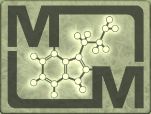 |
MAGISKA MOLEKYLERS WIKI |
Gymnopilus
Innehåller: Psilocybin, Psilocin, Baeocystin
Generell information
Släkte i familjen Cortinariaceae.
Förutom psilocybinliknande molekyler finns det även arter som innehåller kavalaktonerna bis-noryangonin (4-hydroxy-6-(4-hydrostyryl)-2-pyrone) och hispidin (4-hydroxy-6-(3,4-dihydroxystyryl)-2-pyrone)[1] som är strukturellt lika den aktiva drogen i kava. Det finns även en substans som heter gymnopilin som spekuleras ha en psykoaktiv effekt[2], eventuellt genom att verka hämmande på nikotinerga acetylkolinreceptorer (nAChR)[3].
I Sverige återfinns arten Gymnopilus junonius (Gymnopilus spectabilis) som dock förmodligen inte innehåller psilocybin. Observera även att små exemplar bl.a kan förväxlas med giftiga arter i släktet Galerina.
Under 2010-talet påträffades flera flishögar med G. luteofolius i norra Norge[4] det är okänt hur de dök upp där då arten normalt finns i betydligt varmare klimat som södra USA, Brazilien m.m.
i Japan finns det rapporter om svampförgiftningar med psykiska effekter och namnet "laughing gyms" ger en ledtråd om effekterna. I USA har ganska många personer haft framgångsrika resultat av att äta de inhemska aktiva arterna.
Enda nackdelen är att smaken av svamparna är mycket bitter, en egenskap som tillskrivs gymnopilin.
Aktiva arter
| “ | To date, 10 species have been shown to be psilocybinactive, according to a survey of the scientific literature by Allen and Gartz (1992). They are G. aeruginosus, G. braendlei, G. intermedius, G. luteoviridis, G. liquiritiae, G. lutes, G. purpuratus, G. spectabilis, G. validipes, and G. viridans (see also Ha tfield et al. 1978). I believe an additional species, G. luteofolius, is also active. (The analysis of this species has not yet been reported in the literature.) G. luteofolius bruises bluish, especially in cold weather. Additionally, a Mexican Gymnopilus, Gymnopilus subpurpuratus, is also likely to be active, given its green bruising reaction (Stamets 1996).
Small amounts of the active compound baeocystin (.02% to .05%) have been found in G. purpuratus (GARTZ 1996). Of G. spectabilis, STAMETS (citing TANAKA et al. 1993) notes that recent studies of Japanese mushrooms detected no psilocybin, ‚Äúbut identified a new hallucinogen, which they described as belonging to a group of ‚Äėneurotoxic‚Äô oligoisoprenoids, with depolarizing activity that was demonstrated on rodent neurons. (No human bioassays were conducted.)‚ÄĚ (STAMETS 1996). OTT notes that bis-noryangonin (a chemical apparently structurally similar to the active pyrones found in Piper methysticum) has been found in G. spectabilis (OTT 1996, citing HATFIELD & BRADY 1969; HATFIELD & BRADY 1971; and OTT 1976). However, JOCHEN GARTZ points out that this compound is inactive (GARTZ 1996). |
‚ÄĚ |
En ny DNA-studie från 2020 visar att Gymnopilus junonius består av flera arter med liknande utseende[5]. G. junonius finns inte i Nordamerika eller Norra Asien där den anses vara psykoaktiv. Denna upptäckten kan förklara varför den europeiska G. junonius sällan/inte rapporterats i fallbeskrivningar. Personer som trippat på den i Europa kan ha hittat andra arter.
| “ | One striking finding is that Gymnopilus junonius does not occur in North America, and is not psychoactive. It occurs in Europe, Australia and South America, solving the mystery of why European big laughing gyms consistently fail to cause laughter.
The mushrooms we have been calling Gymnopilus junonius in eastern North America fall into four species - the previously described Gymnopilus subspectabilis and G. luteus, and the newly named Gymnopilus voitkii and Gymnopilus speciosissimus. Only G. speciosissimus is mentioned as staining green in the paper, but some or all of the others definitely also contain psilocybin. The species can be difficult to tell apart macroscopically, but are easy to separate with a microscope or via DNA sequencing. ...Gymnopilus orientispectabilis is also named here, a large, hallucinogenic species from Japan. |
‚ÄĚ |
| Namn | Innehåller | Källa / Kommentar |
|---|---|---|
| Gymnopilus aeruginosus | Psilocybin | Gartz, 1994b; Hatfield, Valdez & Smith, 1978 |
| Gymnopilus braendlei | N/A | N/A |
| Gymnopilus intermedius | N/A | N/A |
| Gymnopilus junonius (Gymnopilus spectabilis) | Förmodligen inte Psilocybin | N/A |
| Gymnopilus lateritius | N/A | N/A |
| Gymnopilus liquiritiae | Psilocybin | Koike et al., 1981 |
| Gymnopilus luteofolius | N/A | N/A |
| Gymnopilus luteoviridis | N/A | N/A |
| Gymnopilus luteus | Psilocybin | Hatfield, Valdez & Smith, 1978 |
| Gymnopilus orientispectabilis | bis-noryangonin, gymnopilin | Troddes tidigare vara Gymnopilus junonius. Återfinns i Asien och är psykoaktiv[1] och [2] |
| Gymnopilus purpuratus | Psilocybin, psilocin, baeocystin | Gartz, 1989c; Gartz, 1991; Gartz, 1992b; Gartz, 1993a; Gartz, 1994b; Gartz, 1996; Kreisel & Lindequist, 1988 |
| Gymnopilus sapineus | N/A | N/A |
| Gymnopilus speciosissimus | Psilocybin, | Psilocybinreferens: Buck, 1967; Hatfield, Valdez and Smith, 1977. Detta är en art från Nordamerika som tidigare troddes vara Gymnopilus junonius |
| Gymnopilus subpurpuratus | N/A | N/A |
| Gymnopilus validipes | Psilocybin | Hatfield, Valdez & Smith, 1978; Unsigned, 1972b |
| Gymnopilus viridans | Psilocybin | Hatfield, Valdez & Smith, 1978 |
| Gymnopilus voitkii | N/A | N/A. Troddes tidigare vara Gymnopilus junonius |
Externa länkar
- ‚ÜĎ 1,0 1,1 Occurrence of bis-noryangonin in Gymnopilus spectabilis. (Hatfield, 1969)
- ‚ÜĎ 2,0 2,1 Gymnopilin--a substance produced by the hallucinogenic mushroom, Gymnopilus junonius--mobilizes intracellular Ca(2+) in dorsal root ganglion cells. (Miyazaki, 2012)
- ‚ÜĎ Gymnopilins, a product of a hallucinogenic mushroom, inhibit the nicotinic acetylcholine receptor (Kayano, 2014)
- ‚ÜĎ Mathiassen, G., Granmo, A. & Mohn Jenssen, K. 2016: A sensational mushroom find in Lavangsdalen, Troms county. Polarflokken 38 (2): 113-128
- ‚ÜĎ New species in the Gymnopilus junonius group(Basidiomycota: Agaricales) (Thorn, 2020) pdf-version
- ‚ÜĎ Shroomery: New paper on the Gymnopilus junonius group
A Trial Key to GYMNOPILUS in the Pacific Northwest Identifieringsnyckel
Sidan ändrades senast 5 mars 2021 klockan 16.22.
Den här sidan har visats 9 047 gånger.











